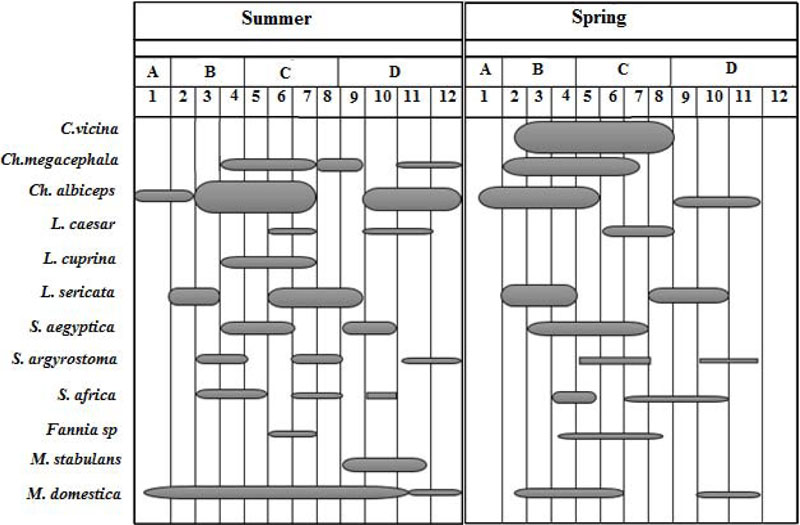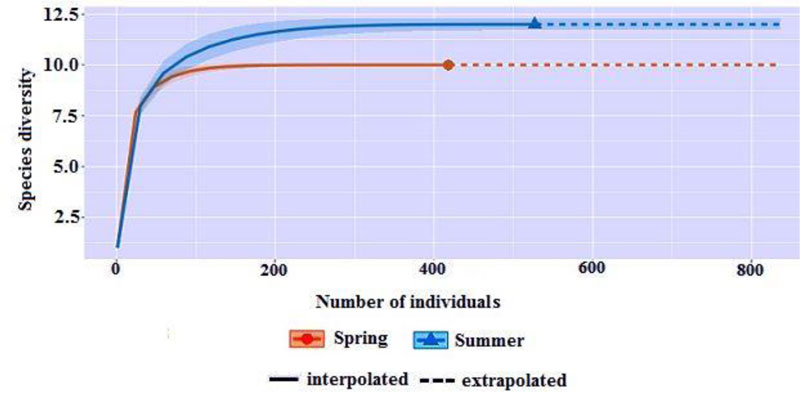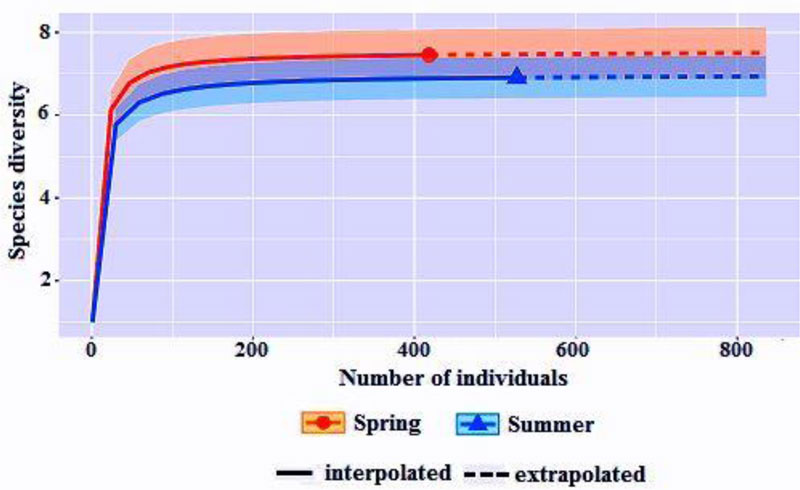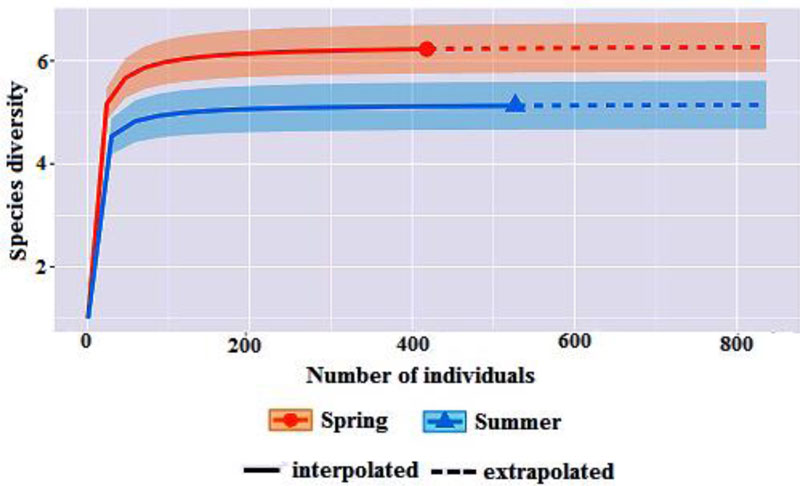All published articles of this journal are available on ScienceDirect.
Diversity of Public Health and Forensic Important Flies Using Three Measures of Hill Numbers in Iran
Abstract
Introduction:
Dipteran species (flies) are one of the most important insects within the public health and forensic fields. Previous studies have shown that flies play an important role in transmitting the diseases and also estimating the time of death, but their diversity by new methods has been less studied.
Methods:
Dipteran specimens were collected from rabbit carcasses during spring and summer 2019 and then identified. We used the three measures of Hill numbers (q=0,1,2) to compare the species diversity between the seasons. The analysis was performed with an R package (iNEXT) that provided in 2014.
Results:
During the present study, 12 dipteran species were collected on rabbit carcasses. L. cuprina and M. stabulans were recorded only from the remains of rabbits in summer. The analysis with iNEXT software showed that species richness (q = 0) in spring is lower than summer and this difference was significant. While, the value of Shannon and Simpson diversity index (q = 1, 2) in summer was lower than in spring. Shannon index value was not significantly different between the seasons, as its confidence intervals almost completely overlapped, but a significant difference in Simpson index was detected between the seasons.
Conclusion:
We conclude that Ch. albiceps, L. sericata and C.vicina are more frequent flies in the study area and dipteran species are more diverse in spring. The current study provided a database in the field of public health and forensic entomology that could be useful for estimating minimum postmortem intervals and also in vector control programs.
1. INTRODUCTION
Diptera is one of the most important insects within the public health and forensic fields, due to their involvement in the transmission of diseases and also estimation of post mortem interval (PMI), PMI is the period of time between insects' establishment of corpses and their finding by the examiner [1, 2]. Dipteran species are efficient vectors of over 100 pathogens, including bacteria, viruses, fungi, and parasites and they could have an important role in dissemination nosocomial infections [1, 3]. In the term of forensics, flies may be used to determine the location of death, detection of the abuse of disabled people, identification of the deceased, and estimation of post mortem interval [4-6]. Medically important families of Diptera are: Calliphoridae, Piophilidae, Sphaeroceridae, Muscidae, Sarcophagidae, and Sepsidae [7, 8]. Dipteran larvae feed on living tissue (causing myiasis) or decomposing vertebrate carrion and can survive on other alternate resources like feces [7].
Different types of bacteria such as; Salmonella sp., Shigella sp., Escherichia coli O157:H7, Salmonella typhi, Bacillus sp., Enterococcus sp., Staphylococcus aureus, and Pseudomonas aeruginosa have been isolated from Chrysomya megacephala (Fabricius) (Diptera: Calliphoridae) and the house fly, Musca domestica L., (Diptera: Muscidae) [3].
Flies are the first colonizer of carcasses and their occurrence is in a predictable wave, hence, PMI could be estimated either by the study of insect’s succession pattern of the carrion, or by tracing the development of the flies’ larvae [2]. Each method could be affected by several factors such as; weather conditions, humidity, stage of decomposition, size and location of the carcass [1, 4]. For intervals more than three days, medico-legal entomology was proven to be a more accurate tool in determining PMI [5, 3].
Different types of carcasses have been used by scientists to study the composition of flies such as; pig, rabbit, cats and rat, but rabbit and pig are the preferred models [2, 5, 7]. A succession model includes data about the time passed between death and the arrival of a specific arthropod species and stage, and can, therefore, be used to estimate both the minimum and maximum PMI as far as 52 days [4, 6].
There are several categories of insects, which can be found around decomposing carrion, including necrophagous species feeding on the carrion (blowflies, flesh flies and house flies); predators and parasites feeding on the necrophagous species; omnivorous species feeding on the carrion and other arthropods [2, 7].
Various studies have been conducted to investigate the role of flies in transmitting the diseases and also estimating the time of death, but the survey of flies’ diversity using Hill numbers has been less studied. As a consequence, the current study described here attempts to investigate the species composition, diversity and successional waves of medically important Diptera on decaying remains.
2. MATERIALS AND METHODS
2.1. Study Site
During the spring and summer of 2019, two separate trials were performed at the Kazerun Health Research Station(29°37′10″N 51°39′15″E). Kazerun is 860 m above sea level and the region's climate is a subtropical steppe type with an average annual temperature of 21.6° C and a rainfall precipitation rate of 257 mm, and is 860 m above sea level. The first trial began on the 18th of April, and was terminated on 3rd May and the second trial began on 20th September, and was terminated on the 3rd of October.
2.2. Carcasses
For each month, four rabbits (1700 -2000 g) were killed by chloroform and placed in separate metal cages (70×40×40cm) with 1.5cm mesh (Fig. 1). Cages were placed directly in contact with the ground in the study area. Permission to use rates as the research animal for the present study was granted by the Ethical Committee of Tehran University of Medical Science. Carcass decomposition stages were classified as fresh, bloated, decayed and dry.
2.3. Sampling Protocol and Statistical Analysis
Sampling of insects was conducted daily (between 13:00 -16:00 hr) during each season. Sampling was done twice daily, for fresh and blot stages of decomposition and then once per day for the next stages. Samples of maggots were collected using forceps. In the present study, immature stages of flies were chosen for the study of succession patterns and during each visit, adult flies activity was recorded. Approximately, 20 larvae were collected from each maggot mass during samplings and then they were put in hot water to die. Another group of 20 larvae was collected for rearing to the mature stage. We used the three measures of Hill numbers of order q: species richness (q=0), Shannon diversity (q=1) and the inverse Simpson diversity (q=2) to compare the species diversity between the two groups.
The parameter q determines the sensitivity of the measure to the relative frequencies.
Species richness (qD) is a measure for the total number of the species in a community: S-1 / lnN (S = total number of species and N = total number of individuals), higher values represent greater richness. Shannon diversity index, limqD =exp [-Σ (pi log pi)], where pi = ni/N (ni is the number of individuals of taxon i, N = total number of individuals). This index accounts for both abundance and evenness of the species present and higher values represent greater diversity. Simpson index: 1/Σpi2, where pi = ni/N (ni is the number of individuals of taxon i, N = total number of individuals).
We hypothesized that species richness and diversity metrics will show a difference between groups. Hill numbers (or the effective number of species), as a static, quantifythe species diversity of a community [8]. We used the sample-size based rarefaction and extrapolation (R/E) curves with 95% confidence intervals based on a bootstrap method for comparison of species diversity between groups. The analysis was performed through iNEXT software provided by Chao et al. (2014) [8]. The detailed formulas and information for the Hill numbers and iNEXT software can be found elsewhere [8].
3. RESULTS
The mean number of flies collected in summer and spring was 527 and 418 individuals, respectively. The most common species were those of Calliphoridae (60%), Sarcophagidae (24%), and Muscidae (16%).
Four decomposition phases were observed (fresh, bloated, decay, advanced decay and dry) and complete decomposition in summer and spring occurred about 12 days (Fig. 1).
During the fresh stage, the first insect attack wave was seen 8 hours after the carcasses were placed. Chrysomya albiceps and M. domestica were the first dipteran species that were present on the carcasses and also they were the most dominant species in the fresh stage during spring. During the next stage, C.vicina, Ch. albiceps, and Lucilia sericata were more frequent species. During the decay stage, species richness and abundance reached a maximum. Dipteran maggots began to migrate from remains and in the end of this stage, large numbers of pupae were observed. At the dry stage, when mostly the bones remained, insect activities reduced. L. cuprina and M. stabulans were recorded only from the remains of rabbits in summer. Succession waves of insects on the remains of rabbits for each sampling day during summer and spring are shown in Fig. (2).
The analysis with iNEXT showed that species richness (q = 0) in spring is lower than summer and this difference was significant (Fig. 3). While, the value of Shannon and Simpson diversity indices (q = 1, 2) in summer was lower than in spring. Shannon index value was not significantly different between the seasons, as its confidence intervals almost completely overlapped (Fig. 4), but a significant difference in Simpson was detected between the seasons (Fig. 5). Therefore, it can be said that in summer, the number of species is more, but the dominance and diversity of them are somewhat lower. However, the species diversity between the two seasons was not statistically significant.




4. DISCUSSION
As previously discussed, flies play a key role in the transmission of diseases and decomposition procedure of human corpse [1, 9]. In this study, we used maggots to study diversity and succession patterns. According to the Smith study, the occurrence of adult fly species on the remains does not necessarily mean that egg-laying or larviposition is occurring [10].

In this study, Calliphorid flies were the first visitors to carcass. This observation was in agreement with previous studies [2, 11]. By contrast, in a few types of research, Sarcophagid and Muscid flies reported as the initial colonizers and the dominant species on carcasses [12, 13]. The reason for this difference might be due to ecological and weather-related factors.
Ch. albiceps was the dominant species and constituted the primary invader in spring and summer. This finding is identical to previous studies in Brazil and Argentina, where Ch. albiceps was the primary invader [2, 11, 14]. Ch. albiceps is aggressive and feeds on both carrion and dipteran larvae, which can explain its dominance over the other species. In the current study, most of the species collected in the decay stage. A succession study on decayed rabbits in Egypt showed that, calliphorids were the first insect family that colonized the carcasses and lasted till the end of the active decay stage [15]. In this research, sarcophagid and muscid flies colonized the carcasses after calliphorid flies. This wave is described by other researchers in different areas [8, 16]. A study on insect succession patterns in exposed carrion in Iran showed that S. africa and C. vicina are two more abundant species in the outdoor environment [2].
According to a study in central Argentina, Ch. albiceps in spring appeared on the carcasses during the first days [10]. Thus, this species has different preferences in different geographical regions. Both Ch. albiceps and C. vicina species mostly occur during cooler seasons and they are also a first wave invader during the decomposition of carcasses [2].
L. sericata, and C. vicina were frequent and constituted the primary colonizers. C. vicina, as a dominant species and also a primary invader, has been reported in different studies [17-20].
In the present study, the adult of Calliphoridae was the first to arrive, within 4 hours of exposure, and oviposition was observed 8 hours later, this observation was in agreement with previous studies [17]. Shean et al. (1993) observed that flies feed on the fresh carcasses within 8 minutes after slaughtered and oviposition was observed 8 hours later [19]. The time difference between the presence of the species on carcass and oviposition can be due to the fact that the insect chooses safe sites for oviposition due to the presence of xenobiotics, predators, and competitors and this process is time-consuming. Mahat indicated that malathion, generally, delayed initial oviposition of dipteran species [21].
CONCLUSION
We conclude that Ch. albiceps, L. sericata, and C.vicina are the most frequent flies in the study area. The current study provided a database in the field of public health and forensic entomology that could be useful for estimating minimum postmortem intervals and also in vector control programs.
ETHICAL APPROVAL AND CONSENT TO PARTICIPATE
The Ethical Committee of the Tehran University of Medical Sciences, Iran has granted permission to use rabbits as a research animal for this study (IR.TUMS.SPH.REC.1397.053).
HUMAN AND ANIMAL RIGHTS
All animal research procedures followed were in accordance with theguidelines and protocols of the Islamic Republic of Iran, Ministry of Health and Medical Education.
CONSENT FOR PUBLICATION
Not applicable.
AVAILABILITY OF DATA AND MATERIALS
The data supporting the findings of the article is available at Tehran University of Medical Sciences at http://sph.tums.ac.ir/emeave/portal/home/?48259/medical-entomology-and-vector-control.
FUNDING
This study was financially supported by Tehran University of Medical Sciences. (Project No.: 38345).
CONFLICT OF INTEREST
The author declares no conflict of interest, financial or otherwise.
ACKNOWLEDGEMENTS
This paper is extracted from parts of the dissertation of DK in medical entomology of Tehran University of Medical Sciences, Tehran, Iran. The author(s) have received financial support from Tehran University of Medical Sciences, Project No. 38345. We would like to thank the Shiraz University of Medical Sciences, Iran, for their kind cooperation. We would like to thank Mohammad Ali Oshaghi Alimohammad Alimohammadi and Sayena Rafizadeh.


